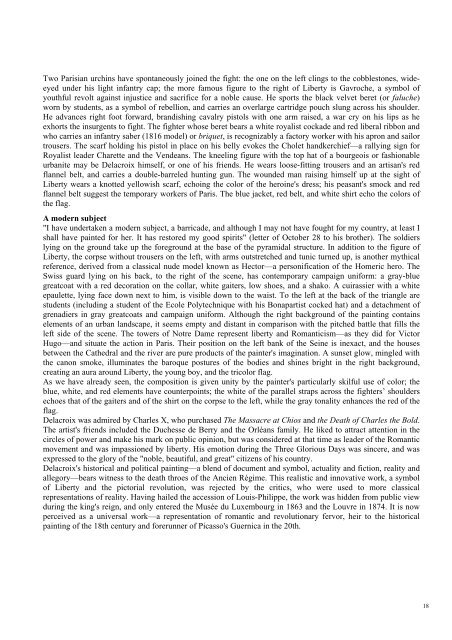The Galerie du Temps at the Louvre-Lens A unique presentation of ...
The Galerie du Temps at the Louvre-Lens A unique presentation of ...
The Galerie du Temps at the Louvre-Lens A unique presentation of ...
You also want an ePaper? Increase the reach of your titles
YUMPU automatically turns print PDFs into web optimized ePapers that Google loves.
Two Parisian urchins have spontaneously joined <strong>the</strong> fight: <strong>the</strong> one on <strong>the</strong> left clings to <strong>the</strong> cobblestones, wideeyed<br />
under his light infantry cap; <strong>the</strong> more famous figure to <strong>the</strong> right <strong>of</strong> Liberty is Gavroche, a symbol <strong>of</strong><br />
youthful revolt against injustice and sacrifice for a noble cause. He sports <strong>the</strong> black velvet beret (or faluche)<br />
worn by students, as a symbol <strong>of</strong> rebellion, and carries an overlarge cartridge pouch slung across his shoulder.<br />
He advances right foot forward, brandishing cavalry pistols with one arm raised, a war cry on his lips as he<br />
exhorts <strong>the</strong> insurgents to fight. <strong>The</strong> fighter whose beret bears a white royalist cockade and red liberal ribbon and<br />
who carries an infantry saber (1816 model) or briquet, is recognizably a factory worker with his apron and sailor<br />
trousers. <strong>The</strong> scarf holding his pistol in place on his belly evokes <strong>the</strong> Cholet handkerchief—a rallying sign for<br />
Royalist leader Charette and <strong>the</strong> Vendeans. <strong>The</strong> kneeling figure with <strong>the</strong> top h<strong>at</strong> <strong>of</strong> a bourgeois or fashionable<br />
urbanite may be Delacroix himself, or one <strong>of</strong> his friends. He wears loose-fitting trousers and an artisan's red<br />
flannel belt, and carries a double-barreled hunting gun. <strong>The</strong> wounded man raising himself up <strong>at</strong> <strong>the</strong> sight <strong>of</strong><br />
Liberty wears a knotted yellowish scarf, echoing <strong>the</strong> color <strong>of</strong> <strong>the</strong> heroine's dress; his peasant's smock and red<br />
flannel belt suggest <strong>the</strong> temporary workers <strong>of</strong> Paris. <strong>The</strong> blue jacket, red belt, and white shirt echo <strong>the</strong> colors <strong>of</strong><br />
<strong>the</strong> flag.<br />
A modern subject<br />
"I have undertaken a modern subject, a barricade, and although I may not have fought for my country, <strong>at</strong> least I<br />
shall have painted for her. It has restored my good spirits" (letter <strong>of</strong> October 28 to his bro<strong>the</strong>r). <strong>The</strong> soldiers<br />
lying on <strong>the</strong> ground take up <strong>the</strong> foreground <strong>at</strong> <strong>the</strong> base <strong>of</strong> <strong>the</strong> pyramidal structure. In addition to <strong>the</strong> figure <strong>of</strong><br />
Liberty, <strong>the</strong> corpse without trousers on <strong>the</strong> left, with arms outstretched and tunic turned up, is ano<strong>the</strong>r mythical<br />
reference, derived from a classical nude model known as Hector—a personific<strong>at</strong>ion <strong>of</strong> <strong>the</strong> Homeric hero. <strong>The</strong><br />
Swiss guard lying on his back, to <strong>the</strong> right <strong>of</strong> <strong>the</strong> scene, has contemporary campaign uniform: a gray-blue<br />
gre<strong>at</strong>co<strong>at</strong> with a red decor<strong>at</strong>ion on <strong>the</strong> collar, white gaiters, low shoes, and a shako. A cuirassier with a white<br />
epaulette, lying face down next to him, is visible down to <strong>the</strong> waist. To <strong>the</strong> left <strong>at</strong> <strong>the</strong> back <strong>of</strong> <strong>the</strong> triangle are<br />
students (including a student <strong>of</strong> <strong>the</strong> Ecole Polytechnique with his Bonapartist cocked h<strong>at</strong>) and a detachment <strong>of</strong><br />
grenadiers in gray gre<strong>at</strong>co<strong>at</strong>s and campaign uniform. Although <strong>the</strong> right background <strong>of</strong> <strong>the</strong> painting contains<br />
elements <strong>of</strong> an urban landscape, it seems empty and distant in comparison with <strong>the</strong> pitched b<strong>at</strong>tle th<strong>at</strong> fills <strong>the</strong><br />
left side <strong>of</strong> <strong>the</strong> scene. <strong>The</strong> towers <strong>of</strong> Notre Dame represent liberty and Romanticism—as <strong>the</strong>y did for Victor<br />
Hugo—and situ<strong>at</strong>e <strong>the</strong> action in Paris. <strong>The</strong>ir position on <strong>the</strong> left bank <strong>of</strong> <strong>the</strong> Seine is inexact, and <strong>the</strong> houses<br />
between <strong>the</strong> C<strong>at</strong>hedral and <strong>the</strong> river are pure pro<strong>du</strong>cts <strong>of</strong> <strong>the</strong> painter's imagin<strong>at</strong>ion. A sunset glow, mingled with<br />
<strong>the</strong> canon smoke, illumin<strong>at</strong>es <strong>the</strong> baroque postures <strong>of</strong> <strong>the</strong> bodies and shines bright in <strong>the</strong> right background,<br />
cre<strong>at</strong>ing an aura around Liberty, <strong>the</strong> young boy, and <strong>the</strong> tricolor flag.<br />
As we have already seen, <strong>the</strong> composition is given unity by <strong>the</strong> painter's particularly skilful use <strong>of</strong> color; <strong>the</strong><br />
blue, white, and red elements have counterpoints; <strong>the</strong> white <strong>of</strong> <strong>the</strong> parallel straps across <strong>the</strong> fighters’ shoulders<br />
echoes th<strong>at</strong> <strong>of</strong> <strong>the</strong> gaiters and <strong>of</strong> <strong>the</strong> shirt on <strong>the</strong> corpse to <strong>the</strong> left, while <strong>the</strong> gray tonality enhances <strong>the</strong> red <strong>of</strong> <strong>the</strong><br />
flag.<br />
Delacroix was admired by Charles X, who purchased <strong>The</strong> Massacre <strong>at</strong> Chios and <strong>the</strong> De<strong>at</strong>h <strong>of</strong> Charles <strong>the</strong> Bold.<br />
<strong>The</strong> artist's friends included <strong>the</strong> Duchesse de Berry and <strong>the</strong> Orléans family. He liked to <strong>at</strong>tract <strong>at</strong>tention in <strong>the</strong><br />
circles <strong>of</strong> power and make his mark on public opinion, but was considered <strong>at</strong> th<strong>at</strong> time as leader <strong>of</strong> <strong>the</strong> Romantic<br />
movement and was impassioned by liberty. His emotion <strong>du</strong>ring <strong>the</strong> Three Glorious Days was sincere, and was<br />
expressed to <strong>the</strong> glory <strong>of</strong> <strong>the</strong> "noble, beautiful, and gre<strong>at</strong>" citizens <strong>of</strong> his country.<br />
Delacroix's historical and political painting—a blend <strong>of</strong> document and symbol, actuality and fiction, reality and<br />
allegory—bears witness to <strong>the</strong> de<strong>at</strong>h throes <strong>of</strong> <strong>the</strong> Ancien Régime. This realistic and innov<strong>at</strong>ive work, a symbol<br />
<strong>of</strong> Liberty and <strong>the</strong> pictorial revolution, was rejected by <strong>the</strong> critics, who were used to more classical<br />
represent<strong>at</strong>ions <strong>of</strong> reality. Having hailed <strong>the</strong> accession <strong>of</strong> Louis-Philippe, <strong>the</strong> work was hidden from public view<br />
<strong>du</strong>ring <strong>the</strong> king's reign, and only entered <strong>the</strong> Musée <strong>du</strong> Luxembourg in 1863 and <strong>the</strong> <strong>Louvre</strong> in 1874. It is now<br />
perceived as a universal work—a represent<strong>at</strong>ion <strong>of</strong> romantic and revolutionary fervor, heir to <strong>the</strong> historical<br />
painting <strong>of</strong> <strong>the</strong> 18th century and forerunner <strong>of</strong> Picasso's Guernica in <strong>the</strong> 20th.<br />
18



